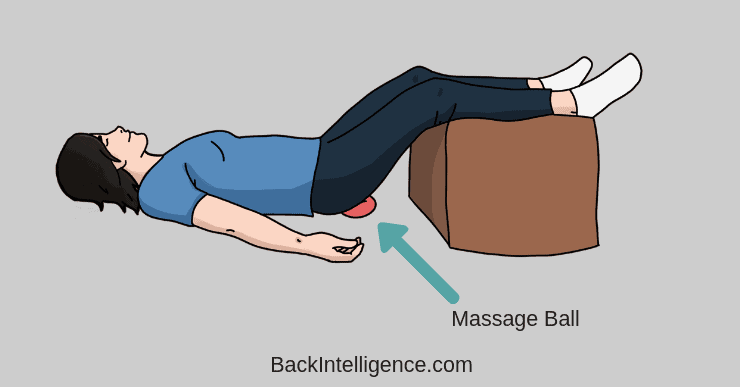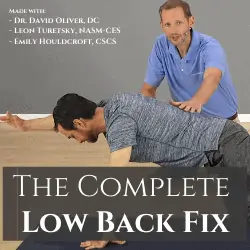
If you’ve ever felt pain in your tailbone while sitting, you’ve experienced what is known as Coccydynia (medical term).
Tailbone pain (Coccydynia) is a painful condition that can be debilitating in some cases. While tailbone pain can be annoying and disruptive to your life, most cases resolve within a few weeks to months.[1] In the meantime, there are a variety of things you can try to minimize your symptoms, which we will outline below.
What is Tailbone pain?
Tailbone pain is simply pain that occurs around the tailbone (aka Coccyx), which is the bony structure at the base of the spine.
The coccyx is at the very bottom of the spine. It makes up the lowest part of the sacrum, which consists of 3 to 5 vertebral segments that are fused. While this bone is quite small, it serves quite a few functions: It helps to support the spine and many muscles, tendons, and ligaments that run through the hip, low back and pelvic area.
Here’s an image showing where your tailbone is:
What can cause Tailbone pain?
• Prolonged or repetitive sitting on hard, narrow, and/or uncomfortable surfaces.
• Leaning back while seated (Puts more pressure on coccyx)
• External trauma that typically occurs as the result of a backwards fall that leads to a bruised, dislocated, or broken tailbone.
• Internal trauma that typically occurs during childbirth, most commonly when delivery is difficult, or instruments are used to assist with delivery.
Source: [1]
Tailbone pain can also be the result of non-traumatic issues, such as:
• Degenerative disc or joint disease.
• Sitting in a poor posture.
• Hypomobility or hypermobility of the sacrococcygeal joint.
• Referred pain from another area of the body.
• Infections, bone spurs and growths (rare).
Source: [1]
Check out the image below showing how poor sitting posture can put MORE pressure on the tailbone:
Risk factors for tailbone pain include:
• Women are 5 times more likely than men to suffer with tailbone pain.[1][2][4]
• Individuals with increased body mass index are 3 times more like to develop tailbone pain.[3]
• Adolescents and adults are more likely to develop tailbone pain than children.[1]
• Rapid weight loss can result in the development of tailbone pain due to the loss of cushioning.[1]
Symptoms of Tailbone Pain Include:
• Pain over the tailbone or surrounding muscles[4][5]
• Pain is usually worsened with prolonged sitting, standing or leaning back while seated[1][4]
• Pain gets worse when standing up from a seated position[1]
• Pain may be worsened with sex and bowel movements[1][4]
• Pain may be associated with low back pain[5]
5 Ways to treat Tailbone from home
There are a variety of home remedies you can try to manage your tailbone pain. Below we’ll outline 5 strategies to try from the comfort of your own home.
Over-the-counter non-steroidal anti-inflammatory drugs (NSAIDS) – Like Advil
– Can help to reduce inflammation in the area and provide pain relief.
– Topicals pain creams provide similar pain relief but have fewer side effects than oral pain medications.
Source: [1][2][4]
Ice and heat
– A combination of hot and cold packs can help to decrease inflammation and pain, and increase blood flow to the area to encourage healing.
– Apply a moist heat pack to the area to 15 to 20 minutes, rest for 15 to 20 minutes, and then apply an ice pack to the area for 10 to 15 minutes.
– Repeat as often as possible throughout the day.
Source: [1][2][4]
Coccyx Pillow Or Donut Shape Pillow
– Takes pressure off of the tailbone and allows it time to heal.
Source: [1][2][4]
Self massage the area
– Massage the muscles around the area of the tailbone to release muscle tension and decrease pain.
Source: [1]
Stretching/Exercise
– Gentle stretching and strengthening exercises can help to stretch and strengthen the muscles around the tailbone and help to minimize pain.
– Postural exercises can also help to improve posture, allowing for proper alignment of the spine and decreased stress on the tailbone.
Source: [4]
The Complete Low Back Fix (With Dr. Oliver, DC)
Ease your Low back pain, gain mobility and get back to the things you enjoy doing.
Learn More
5 Exercises to relieve tailbone pain
Simple exercises can provide much needed relief from tailbone pain. Since the tailbone is located at the bottom of the spine, these exercises focus on stretching and strengthening the muscles in this area to allow for proper alignment and better support of the spine, which helps to relieve tailbone pain.
#1: Glute & Piriformis Stretch
This stretches the glutes and piriformis muscles which can relieve some pain and discomfort in the region.
How to do it:
– Lie on your back as shown.
– Cross one foot over the opposite knee and keep your foot on the floor/mat.
– Pull the knee with the opposite hand toward the opposite shoulder.
– Hold 20-30 seconds. Repeat 2-3 times per side.
#2: Child’s Pose
Stretches the back and pelvic floor muscles
How to do it:
– Begin by positioning yourself on the floor on your hands and knees with your knees slightly wider than your hips.
– Turn your toes inwards to touch and push your hips backwards while bending your knees.
– Once you’re in a comfortable position, straighten your arms forward and allow your head to fall forwards into a relaxed position.
– Hold this position for 15 to 20 seconds.
– Slowly return to the starting position.
– Aim for 3 repetitions.
#3: Cat Cow Stretch
Loosens the muscles of the back and abdomen. Also, gently separates the spinal bones, taking pressure off of the tailbone.
How to do it:
– Begin this stretch on your hands and knees. Inhale and let your stomach “drop” towards the floor as you look up towards the ceiling.
– Follow this by exhaling and slowly rounding your spine while pressing into the floor with your hands and slightly curving your neck to look at your feet.
– Aim for 10 repetitions of this stretch and do 2-3 sets.
Learn More
#4: Pigeon Pose
Stretches the muscles of the hips, buttocks and pelvic floor.
How to do it:
– Position one leg in front of the other.
– Bring the outer thigh of front leg down to the floor (as much as you can).
– If you need to make this stretch deeper, simply lean forward a little.
– Hold this position for 15 to 20 seconds.
– Aim for 2 to 3 repetitions on each side.
#5: Pelvic Tilt
Strengthens muscles of the pelvic floor and core which can promote good posture and as a result, take pressure off the tailbone.
How to do it:
– Begin by lying on your back with your feet positioned flat on the floor
– Inhale by filling your belly up with air
– As you Exhale, draw in your abdominal muscles by drawing your belly button down towards the floor and slightly up towards your head
– As you are exhaling and drawing your belly button down, you should be flattening your lower back against the floor
– Hold this position for 5 seconds.
– Aim for 10 repetitions.
Conclusion
The good news is that while tailbone pain can be uncomfortable, 90% of cases respond well to conservative treatment, so chances are your pain will subside over time.
Tailbone pain from poor posture video:
Related:
7 Lower back stretches
SI Joint Pain relief
Sciatica pain exercises
Herniated disc exercises
Lumbar stenosis exrcises
Sources:
[1] Lirette L, Chaiban G, Tolba R, Hazem E. Coccydynia: an overview of the anatomy, etiology, and treatment of coccyx pain. Ochsner J. 2014 Spring;14(1): 84–87.
[2] Howard P, Dolan A, Falco A, Holland B, Wilkinson C, Zink A. A comparison of conservative interventions and their effectiveness for coccydynia: a systematic review. Journal of Manual & Manipulative Therapy. 2013;21(4):213-219. doi:10.1179/2042618613y.0000000040
[3] Marinko L, Pecci M. Clinical Decision Making for the Evaluation and Management of Coccydynia: 2 Case Reports. Journal of Orthopaedic & Sports Physical Therapy. 2014;44(8):615-621. doi:10.2519/jospt.2014.4850
Licensed chiropractor, DC (Owner of Forme Clinic, Stoney Creek, ON, L8G 1B9)
Dr. Shaina McQuilkie graduated from Brock University in 2004 with a Bachelor of Kinesiology (Honours). She then attended D’Youville College, in Buffalo, New York and obtained her Doctorate of Chiropractic Degree in 2008. After graduating, Dr. McQuilkie practiced in a multi-disciplinary healthcare facility based in Hamilton, Ontario gaining experience treating a variety of musculoskeletal injuries.















